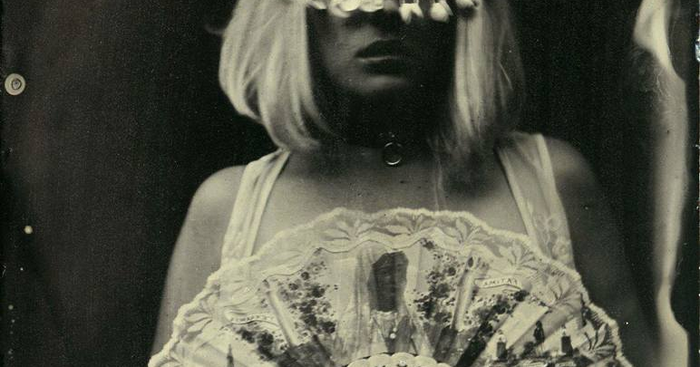
Now Showing: Strange Girls Never Die
Published November 7th, 2015 by Russ White
Strangeness and Spice and More or Less Nice: An interview with artist and curator Rhys Jones
“Strange Girls Never Die,” a group show featuring over two dozen different artists opens tonight at CO Exhibitions. The blowout opening party boasts incredibly diverse art, live performances from four bands, a tintype photo booth, and a mobile metal forgery out front. Russ White sat down with the show’s curator and organizer, local printmaker Rhys Jones, to talk about feminism, identity politics, art curation, and strange girls in all their glory.
Russ White: So tell me about the genesis of the show.
Rhys Jones: The phrase “Strange Girls Never Die” first came to being when I was doing sign-painting at the Coney Island Sideshow School in the summer of 2013. It was a weeklong, intensive class. There were I think 4, maybe 5 students, plus our instructor Marie Roberts, who is the resident banner painter out at Coney Island; she actually has a piece in the show as well. We had to make up characters that we were painting our banners for, and mine was the Mermistress from Hell. One of the bullets I put on the banner says “Strange Girls Never Die,” which was kind of a play on the tradition of having a bullet that says “Alive!” on sideshow banners. But “Strange Girls” has been an umbrella term in sideshow and freakshow culture for your tattooed ladies, your lobster girls, your bearded ladies, your fat ladies, et cetera. One of my favorite vintage banners says something to the effect of “Strange girls: Can they marry like other girls? Can they have children? How can they be as happy as they are?”
I ended up getting “Strange Girls Never Die” tattooed on me to commemorate the trip, and I came back and started working with it, both as a phrase in my printmaking work and as a theme and motif in my photography work as well. And I’ve been sort of unconsciously curating a show of other strange girl artists ever since.
RW: Where are the artists from? Are they mostly local or from all over?
RJ: The bulk of the artists are local, but we do have five New York artists, a couple from Oakland, one from Seattle, one from Rhode Island, one from Austin. So there is not a ton, but a fair number from out of state.
RW: And I noticed that there are two men involved in the show.
RJ: Yes, two whole dudes. Luke Hillestad and Ryan Ketchum are my two dudes, and I chose them specifically because their work has always struck me as appropriate for the theme. Part of this is that it’s a very female-heavy show, and very intentionally so. We’ve come so far or whatever, but female artists are still largely underrepresented, especially not “on the fringes” kind of female artists. So I really wanted to give them a platform. I mean, people still think that art comparing female bodies to flowers is fucking relevant, so that also kind of put a fire under my ass to create a very female-focused show. I think it’s sort of like “Yeah, I should probably get a couple dudes in there, too.”
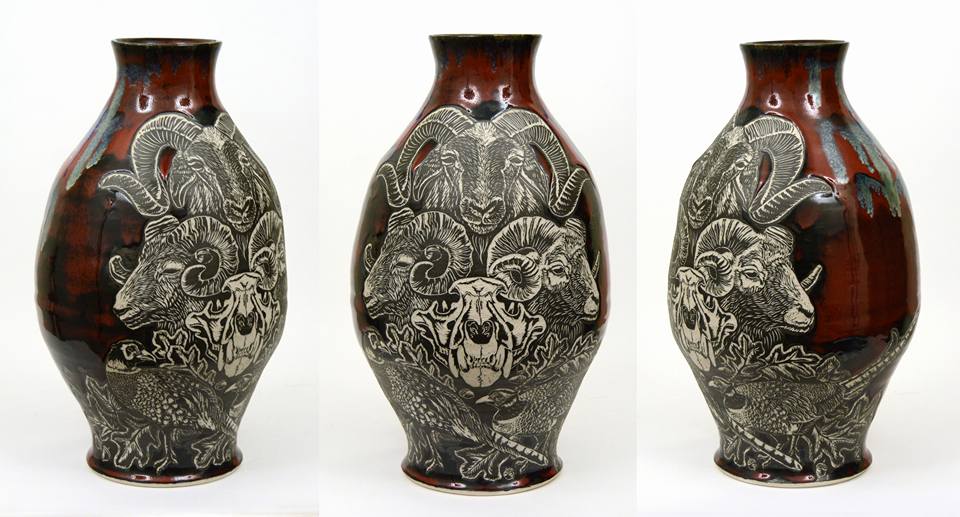 Ellie Anna Bryan, Fire Vase, porcelain, glaze, & slip
Ellie Anna Bryan, Fire Vase, porcelain, glaze, & slip
RW: There’s actually a great diversity of styles, media, and subject matter in the show. It touches on politics, gender, race; there’s big stuff and there’s little stuff, there’s serious stuff and there’s psychobilly, there’s work that is absolutely beautiful right next to super grotesque drawings. What is it about all this work that makes sense to you. Is it just that it is made by strange girls or about strange girls?
RJ: Yeah, it was very important to me that I create an eclectic show, in part because it speaks to my personal taste in things. But because of my work with the strange girls motif, both selling t-shirts and doing the photo series and then talking to people about this show, it’s clear what a huge breadth of people there are who both identify as strange girls and who love having strange girls in their life. There is no typical strange girl. I thought it was important to speak to that breadth by integrating different types of artists. When I first started it, A) I wanted to make sure it wasn’t just the Rhys’s friends show. and I’m glad that I reached out to other artist friends in other cities and had them recommend folks and went crawling on some Facebook groups for friends of friends and stuff like that. But I also wanted to make sure that it wasn’t just a portrait show. So the way that I pitched it to the artists was that I’m looking for work that is both itself about strange girls in some capacity or that was created by an artist who identifies themselves as a strange girl and that that influences their work heavily.
RW: It seems to me that using the term Strange Girls is co-opting something that was originally derogatory. Do you see it that way? I mean, it’s “girls” and not “women,” and it’s “strange” at a time when it wasn’t cool to be strange.
RJ: Yeah, and certainly there are a lot of sticky issues around sideshows and freakshows. Because in some ways, the performers made more money than any of their other contemporaries in any other field, especially the women. I mean, they made a ton of money, but they were also exploited a lot and taken advantage of a lot. And it was also a matter, of, you know, horror at human bodies. But what happened was, people eventually stopped thinking it was okay to look. And I think that that now, in a lot of ways, speaks to how people approach things like disability and otherness: that you’re not supposed to see it, that you’re not supposed to look at it, that it’s not supposed to be obvious to you. But those things that you’re not looking at are huge parts of our identities. I’m disabled, and it’s not something that people can actually physically see on me, but it is a huge part of my life. I cannot separate myself from that, and so when someone basically able-washes me, it takes away a part of my identity.
I think it’s a mixed bag. It depends how you approach it. Like approaching it from a voyeuristic, “Heh heh heh, look how gross and weird this is” versus appreciating the variation and difference of people, like the difference between inherent strangeness, things that you’re born with, and cultivated strangeness, how you’ve created yourself to be strange and for whatever reason: whether it’s a safety blanket, a way of separating yourself, a way of creating community. And that’s the other thing: strangeness is a very broad term, depending on who you’re talking to.
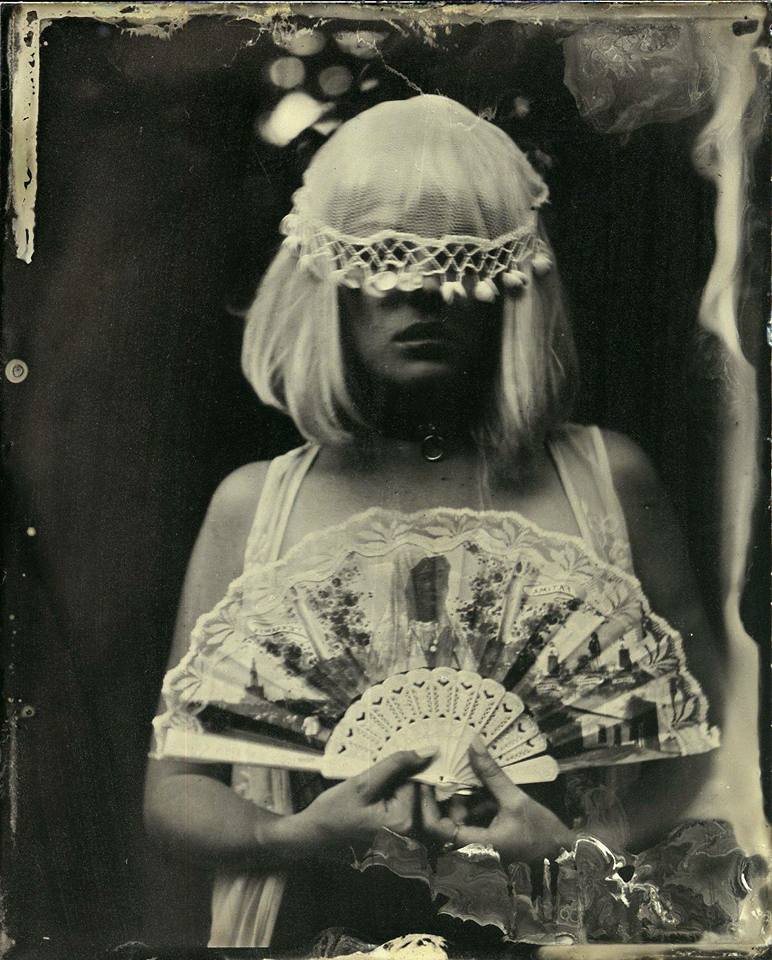 Carla Alexandra Rodriguez, tintype portrait
Carla Alexandra Rodriguez, tintype portrait
RW: Do you see the show ultimately as a celebration of weirdness?
RJ: Oh, absolutely
RW: Do you see it also as a political statement or a fuck you or--
RJ: It’s a fuck you, in a lot of ways, for sure.
RW: A fuck you to who, do you think?
RJ: That’s the thing, and I’ve kind of been thinking about that. I think it’s to the idea of dominant culture, the idea that women are X, Y, and Z, or should be, and that deviation from that is bad or, you know, means you’re never going to be employable. Or that who gets to identify a woman as a woman is predefined. It’s very much a fuck you to that.
But at the same time, it’s also this really cool rallying cry for strange girls, because going through life, we assume that we are the other and the minority. But in reality, there are a fuck-ton of really weird ladies, and it’s a way that a lot of women and female-identified folks create themselves as part of their gender. There’s more of us than we ever think there are. So part of what I wanted to do with this is have it be like “we are many.” There are a lot of us, people dig it, we’re excited about it, and it makes the world a better place.
RW: You said that you started doing the Strange Girls Never Die t-shirts and patches and that those have just kind of exploded.
RJ: Yeah, totally. And what’s been really cool is that I do in-person sales and events, so I get to talk to people when they’re like “Holy shit, yes, this!” It’s either people who themselves are like “This is for me,” or my favorite is people would come in and buy like ten patches and tell me straight up, “This one is for me, and I’m going to give one to each of my friends,” which I love. The response has been really, really positive from people. But also there have been people who got excited about it who I, at first glance, would not have thought of as strange girls, and that’s my own first-glance judgment that we all do. But this person is super excited about it and identifies strongly, and then we have a conversation about it and find more commonalities between us. So it’s been kind of surprising that way.
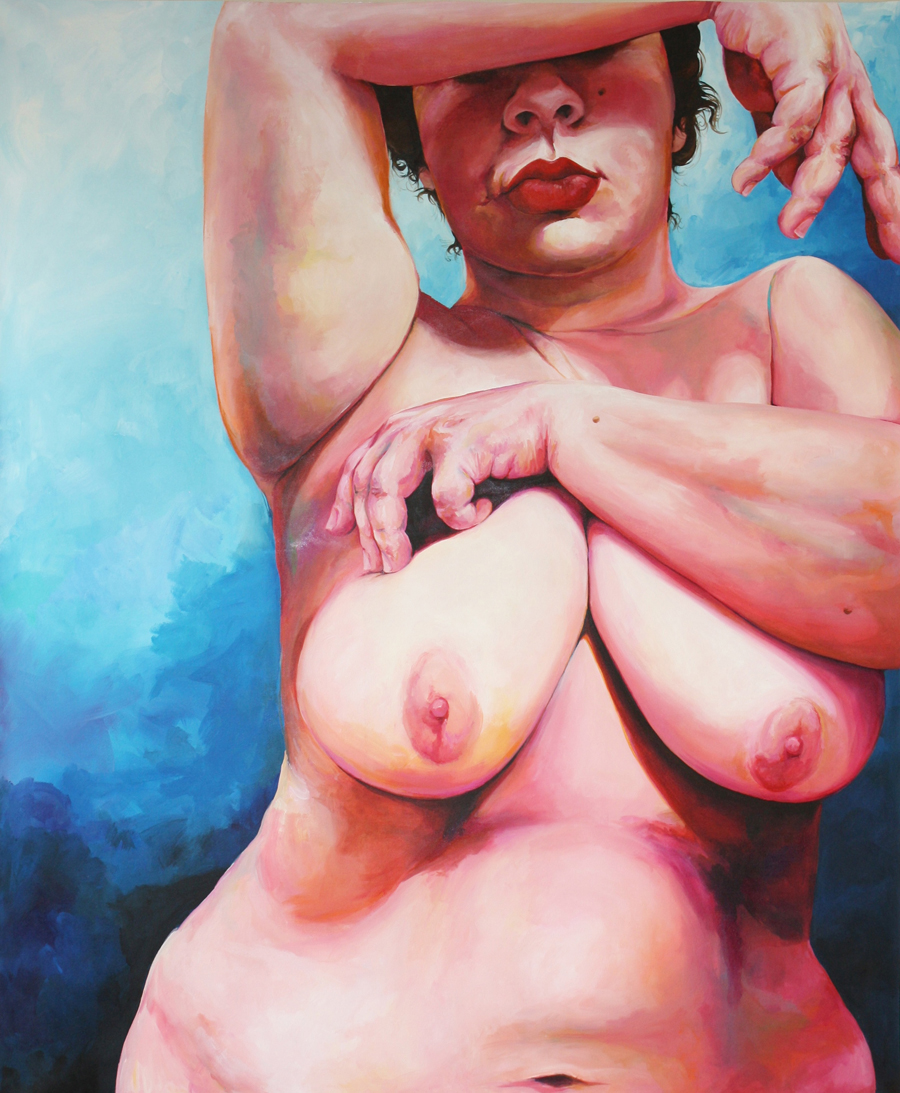 Erin Sandsmark, Self 2, acrylic on canvas
Erin Sandsmark, Self 2, acrylic on canvas
RW: Do you see Strange Girls as a new step in feminism or a variation on the same thing? Do you relate it at all to “mainstream” feminism?
RJ: I don’t know, mainstream feminism is [laughing] a thing right now, especially in terms of being really critical about white feminism being too dominant, and so there’s been a lot of critique around that. But I think that this is in no way divorced from feminism; I think this is certainly a feminist statement in and of itself. It wasn’t necessarily created to be primarily a feminist statement, but perhaps by virtue of being this rallying cry, this celebration, it is itself feminist.
RW: Do you feel like being a feminist is a label that is kind of necessary or would you prefer the “strange girl” label over “feminist”?
RJ: No, I think they’re kind of interchangeable, depending on who you talk to. I don’t like to speak to other people’s identities, and some people need to identify as feminist. Some people associate feminism with feminists who are doing it fucking wrong, which is a lot of them, and so they actively don’t identify as feminist. There’s a lot of ins and outs there, and it varies from person to person. Feminism is absolutely necessary, but what that feminism actually looks like is itself an ever-evolving thing.
RW: If strange girls never die, do you see them becoming normalized over time or it eventually not being strange to be a strange girl?
RJ: Well, for where the phrase itself came from, the idea is that by virtue of our strangeness, we are basically burned into people’s memories forever. We are made immortal by the fact that you cannot forget us, you cannot not see us. And so that stays with you, regardless of where we physically, actually are. In some ways, I see us on the course of culturally starting to embrace more strangeness, especially in the generation coming up now. I don’t know if normalization is the right word, but perhaps there will be less stigma. Fewer opinions on what we can and cannot do with our bodies and lives would be super. I would like that. [Laughing]
RW: [Laughing] Right, good luck with that!
RJ: Yeah, totally.
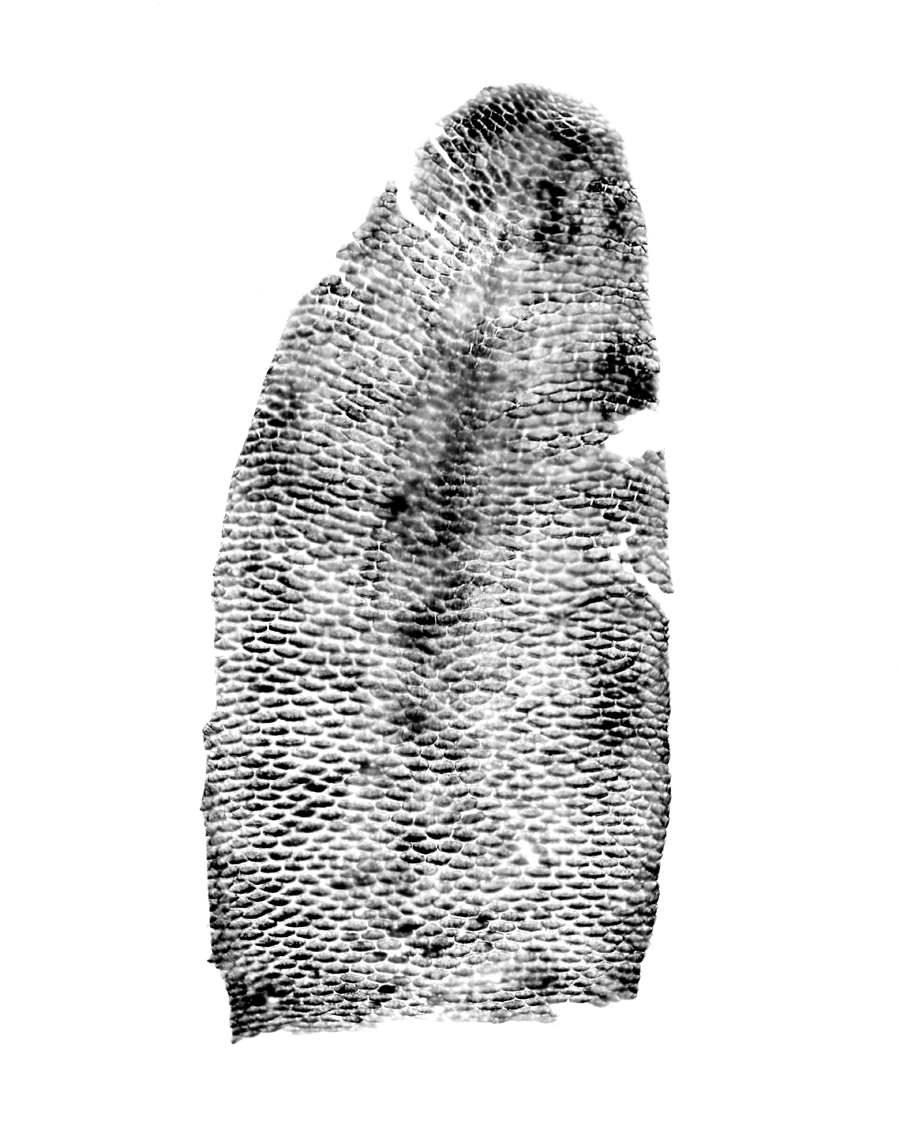 Amber White, identity/dexterity, photogram
Amber White, identity/dexterity, photogram
RW: There are also some pieces in the show that don’t have obvious or overt messages. There’s a drawing of a moon, a few prints that look like bits of snake skin—
RJ: Beaver tail. It’s a skinned beaver tail photogram.
RW: Oh, so, beaver, is that the connection?
RJ: [Laughs] It was kind of a joke with it. The artist for those is Amber White; she’s a friend of mine and a grad student at the U in the art department, and she’s one who identifies very heavily as a strange girl. Part of that identity for her is a really deep connection with nature, both personally and in her work. So that one is an example of the artist identifying as a strange girl and that informing her work rather than the image itself being about strange girls. But the beaver tail is kind of a knee-slap joke, and the moon print is a little bit on the nose, too. But Kara Faye Gregory, the artist, is a total weirdo. And that’s actually a 4-color CMYK screenprint. I saw it at another show, and I actually approached her specifically for that because I was just really floored by how smooth and beautiful that was, just using the four inks.
RW: Yeah, that’s not easy to do.
RJ: Totally. I think my response was like “fuck you!” in that congratulatory kind of way. But I’m not one to necessarily shy away from the on-the-nose part of things, I think it works as a part of the show. As a piece of art it’s beautiful, and whatever drove her to create that is a part of how she identifies.
RW: It’s interesting to see the strangeness expressed in more traditional media. There’s a large oil painting, for instance.
RJ: Yeah, that’s Luke Hillestad, and his oils are incredible. I will never, ever be that kind of artist, which is what I love about curating. Because I know my limits as an artist, so in some ways I am living vicariously through the skill sets of others. And it’s a big part of how I appreciate art. I’m a huge process nerd. So when I look at something and think about how they made that work, I get really wrapped up in other people’s art and get super, like, empathetically excited.
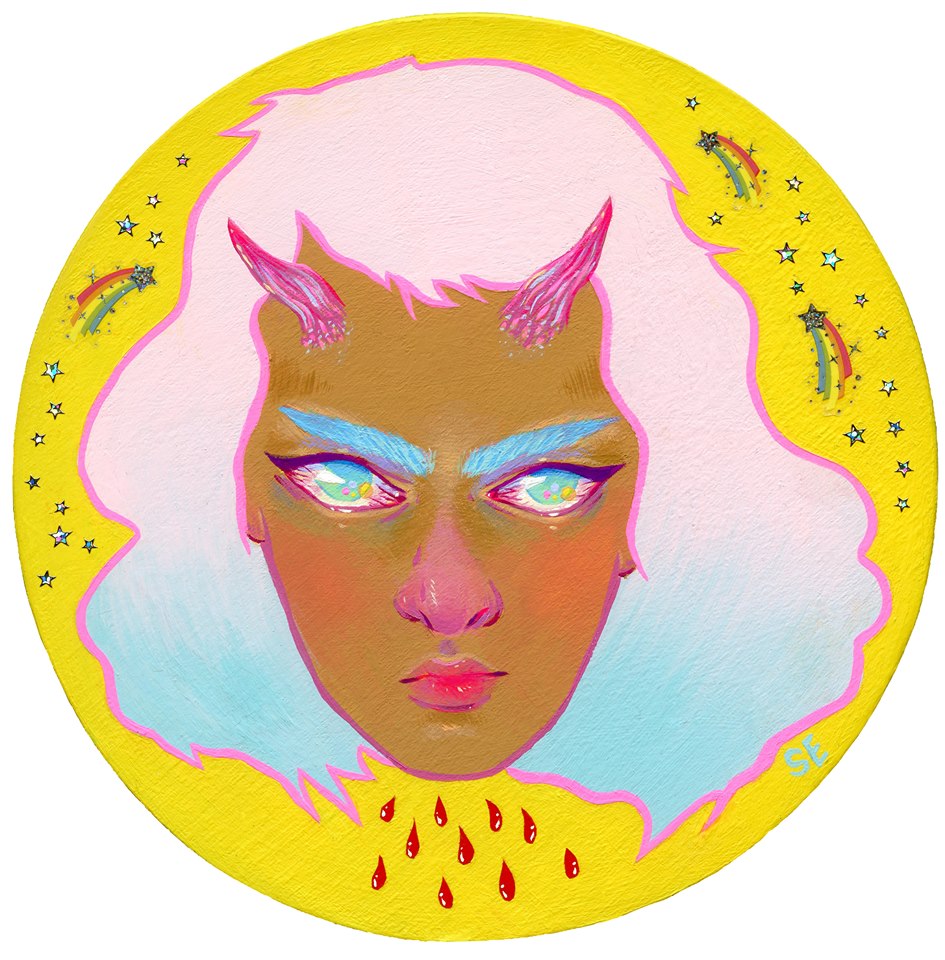 Sabrina Elliott, Cosmic, gouache on wood panel
Sabrina Elliott, Cosmic, gouache on wood panel
RW: So ultimately, is there anything that you hope people will take away from the show?
RJ: I think the celebration of strange girls is really what I want to be there, whether that extends to themselves or to other people in their lives. I don’t think it’s something that you would normally expect a lot of people to be pumped about, but the response to the show has been insane. They’ve never had anything near this kind of response for any of the shows in the gallery. And all of us are just like “what the fuck is going to happen [at the opening]? Where are we going to put all these people?” But I really want people to take away the celebration and the rejection of limits of what female identity and just identity in general can look like, both in artists and your everyday. I’m personally excited that there will be a good representation of teenagers and young folks because this is a show I wish my 14-year old self could have seen. I didn’t have great teenage years, so in a lot of ways, something this affirming and celebratory and free is a really important thing especially for folks in that age group. I mean, high school is brutal, man.
RW: Especially for strange girls.
RJ: Yeah, especially for strange girls, in whatever way that comes out. So I’m personally really warmed up about the idea of teenagers coming here and seeing this and taking that into their identity as they move forward.
RW: Anything else you want to add?
RJ: Just that a bunch of the artists have created new pieces specifically for this show, and that’s something I was particularly excited by. I did approach some artists for specific works of art that I wanted in the show. But there’s a handful of artists that did new pieces for it, and I thought that was so fucking cool. Every artist who I asked said yes, which is amazing, [laughs] considering probably a third to a half of them I didn’t really know personally. And I want to keep doing this, that’s the other discovery that I’ve made. I am really good at organizing and doing this stuff, event planning and coordination. The running joke among the CO Exhibitions and Burlesque folks is that they’re just going to start calling it Rhys Productions.
“Strange Girls Never Die” opens Saturday, November 7th, and runs through December 3rd at CO Exhibitions Gallery.
We can't do it without you.
Help keep independent arts journalism alive in the Twin Cities.